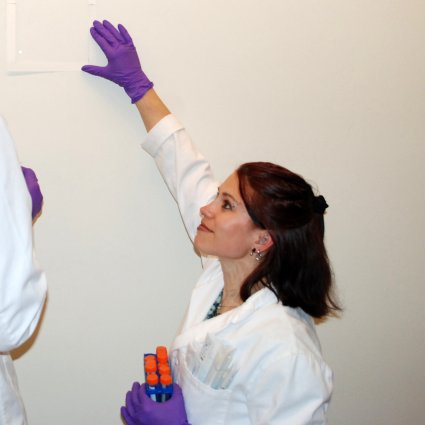The award will allow UO’s Gwynne Mhuireach to pursue research that examines health impacts of microbial diversity in cities
 EUGENE, Ore. — (Nov. 17, 2014) — As a general rule, humans like vegetation. They build neighborhood parks, landscape yards and keep houseplants on windowsills. But what about those who live in urban concrete jungles where greenery is rare? Are they less happy or healthy when deprived of green spaces?
EUGENE, Ore. — (Nov. 17, 2014) — As a general rule, humans like vegetation. They build neighborhood parks, landscape yards and keep houseplants on windowsills. But what about those who live in urban concrete jungles where greenery is rare? Are they less happy or healthy when deprived of green spaces?
Gwynne Mhuireach, a doctoral student in the Department of Landscape Architecture at the University of Oregon, is interested in the potential negative health impacts for people who lack “microbial diversity from nature and the outdoors.” They often are the poorest residents in neighborhoods where urbanization has wiped out vegetation.
A recent grant from the Environmental Protection Agency will allow Mhuireach to further her interdisciplinary research, which draws from microbial ecology, urban design and landscape epidemiology.
“I am ultimately interested in the potential health implications of urban green-space design,” said Mhuireach, who is also a graduate research fellow in the Energy Studies in Buildings Laboratory (ESBL) and in the Center for Biology and the Built Environment (BioBE). “I’m examining alternative mechanisms through which vegetation might impact health, and the socioeconomic dimensions of green space distribution and its health benefits within cities.”
As a recipient of the EPA’s Science to Achieve Results (STAR) fellowship grant, Mhuireach gets $84,000 over two years to pursue her research project, Relationships Among Airborne Microbial Communities, Urban Land Uses and Vegetation Cover: Implications for Urban Planning and Human Health. STAR fellowships go to promising students pursuing careers in environmental science.
“These fellowships are helping our next generation of scientists and engineers earning advanced degrees in environmental sciences conduct cutting-edge research,” said Lek Kadeli, acting assistant administrator for EPA’s Office of Research and Development. “Through this support, EPA is ensuring that the United States will have the scientific knowledge to meet future environmental challenges, which will strengthen our nation’s economy and security, while better protecting our health and environment in addition to combating climate change.”
Mhuireach’s primary adviser Bart Johnson, a professor of landscape architecture, says the project connects the design-and-planning world with groundbreaking research in microbial biology. Mhuireach also is being mentored by BioBE Director Jessica Green, a professor in the Institute of Ecology and Evolution, and by ESBL Director G.Z. Brown, Philip H. Knight Professor in the Department of Architecture. All three have been pivotal influences on her work, she said.
Mhuireach hopes her research will help inform urban planning decisions. Architects often stress the fact that future populations will be dominated by city dwellers, but as planners seek to reduce environmental damage and make cities more sustainable, human health and happiness are sometimes overlooked.
Plants are major sources of microbes and, many researchers say, reducing human exposure to microbial diversity has been implicated in the increase of chronic diseases such as allergies and asthma. The health benefits of a green infrastructure, Mhuireach said, may accrue partly through exposure to the increased microbial diversity that plants deliver.
“A lot of microbial ecologists have studied the dynamics of outdoor microbial communities across space and time, and researchers from many different disciplines have looked at the influence of urban vegetation on people’s health,” Mhuireach said. “However, there is little work linking the two together.”
In her project, Mhuireach will pursue those links by investigating variations in airborne microbial communities in Eugene neighborhoods. She will sample microbes, compare them to the vegetation surrounding each point and analyze the data against health records of nearby residents. She aims to develop a model showing the strength and direction of relationships among urban vegetation patterns, airborne microbial community composition, socioeconomic status and children’s health outcomes.
Understanding environmental influences on public health, Mhuireach said, should help urban planners, designers and policymakers target large-scale investments in public infrastructure projects.
"It's cutting-edge research that could change the way we conceive of the role of urban vegetation in promoting people's health, especially the health of children and members of underserved communities," Johnson said. "Most concepts of good air quality focus on the absence of bad things like pollution. Gwynne is working with the concept that healthy air may be full of tiny organisms that help our immune systems develop or otherwise enhance our health and well-being."
Media Contact: Lewis Taylor, 541-346-2816, lewist@uoregon.edu
Note: The University of Oregon is equipped with an on-campus television studio with a point-of-origin Vyvx connection, which provides broadcast-quality video to networks worldwide via fiber optic network. In addition, there is video access to satellite uplink, and audio access to an ISDN codec for broadcast-quality radio interviews.